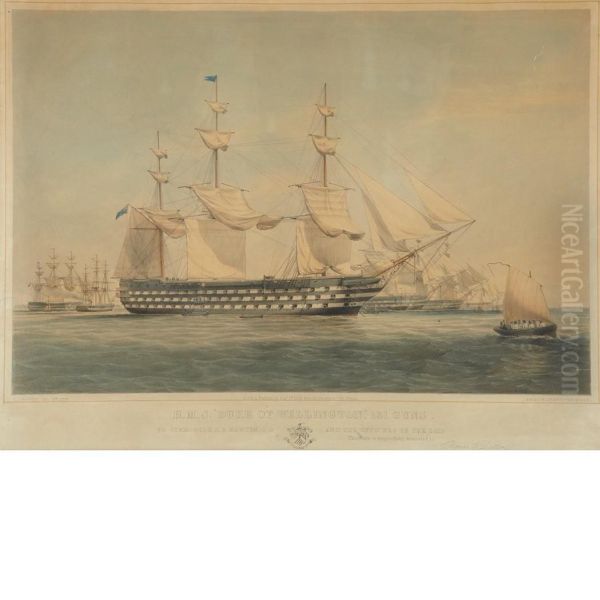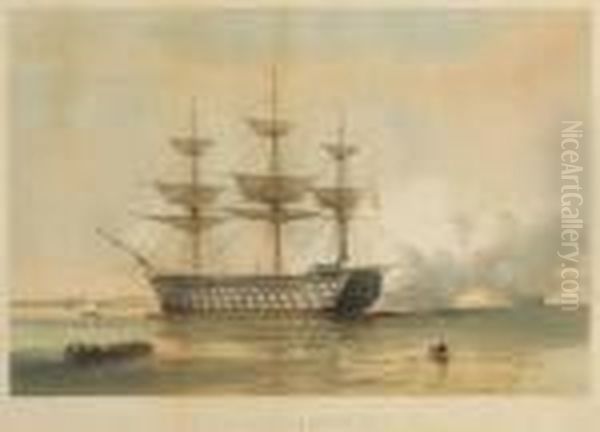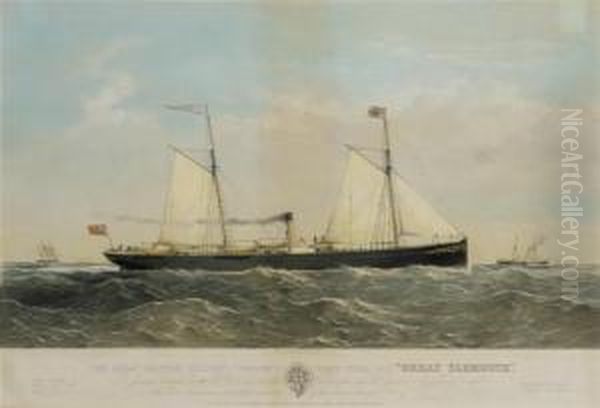Thomas Goldsworth Dutton stands as one of the most accomplished and prolific British maritime artists of the 19th century, particularly renowned for his highly detailed and accurate lithographs of ships. Active during a transformative period in naval architecture and global seafaring, Dutton's work provides an invaluable visual record of the vessels that defined Britain's imperial and commercial power. His prints, often hand-colored, captured the grandeur of naval warships, the sleek lines of clippers and yachts, and the burgeoning power of steam vessels, appealing to a public fascinated by maritime prowess and technological advancement.
The Artist and His Era
While specific details about Thomas Goldsworth Dutton's early life and formal artistic training remain somewhat scarce, it is generally accepted that he was born around 1819 or 1820 and died in 1891. He flourished as an artist from the 1840s through the 1880s, a period that witnessed the zenith of British maritime dominance. This era saw the transition from sail to steam, from wooden hulls to iron and eventually steel, and Dutton was a keen observer and meticulous recorder of these changes. His career coincided with the rise of lithography as a popular medium for disseminating images, making his detailed ship portraits accessible to a wider audience than traditional oil paintings.
Dutton's primary medium was lithography, a planographic printing process invented by Alois Senefelder in 1796. By the mid-19th century, it had become a sophisticated technique capable of producing fine lines and subtle tonal gradations. Dutton mastered this medium, often working from his own drawings or occasionally from sketches or paintings by other artists. His prints were frequently published by leading London firms, most notably Day & Son, who were renowned for their high-quality lithographic work, including chromolithography. The addition of hand-coloring to many of Dutton's prints further enhanced their visual appeal and documentary value, bringing the vessels and seascapes to life.
A Prolific Output: Documenting Naval Power
A significant portion of Thomas Goldsworth Dutton's oeuvre was dedicated to depicting vessels of the Royal Navy. These were not just ships; they were symbols of national pride, technological innovation, and imperial reach. His works meticulously captured the might and majesty of these floating fortresses.

One of his notable works in this domain is "H.M.S. Duke of Wellington." This hand-colored lithograph, published by Day & Son in 1853, measuring approximately 480 x 620mm, portrays the formidable 131-gun first-rate screw-propelled ship of the line. Launched in 1852, she was one of the most powerful warships in the world at the time and served as the flagship of Vice-Admiral Sir Charles Napier in the Baltic campaign during the Crimean War. Dutton’s depiction would have resonated strongly with a public keenly following the exploits of its navy. The detail in the rigging, the portrayal of the hull, and the sense of power emanating from the vessel are characteristic of his skill.
Similarly, his print of "H.M.S. Agamemnon" showcases another significant warship. This hand-colored lithograph, also published by Day & Son and measuring 420 x 615mm, depicts the 91-gun second-rate steam-powered ship of the line. Launched in 1852, the Agamemnon was the first British battleship designed from the keel up to incorporate steam power and a screw propeller. She saw distinguished service in the Crimean War, participating in the bombardment of Sevastopol. Dutton’s print captures her in a dynamic pose, often under sail and steam, emphasizing her hybrid power.
These naval portraits were more than just artistic representations; they were documents of engineering prowess and naval strategy. Dutton's attention to detail ensured that naval officers, shipbuilders, and an interested public could appreciate the specific features of each vessel. His work can be seen in the tradition of earlier marine painters like Nicholas Pocock and Thomas Luny, who also documented naval actions and ships, though Dutton specialized in the print medium for wider distribution.
Chronicling the Age of Steam and Iron
Beyond the Royal Navy, Dutton was a keen observer of the revolution in merchant shipping, particularly the advent of steam power and iron-hulled vessels. His prints celebrated these new titans of the sea, which were shrinking the globe and facilitating international trade and communication on an unprecedented scale.
A fine example is his lithograph of the "Nyanza." This print, measuring 490 x 650mm, depicts the iron screw steamship "Nyanza," built by the Thames Iron and Shipbuilding Company for the Peninsular and Oriental Steam Navigation Company (P&O). The P&O line was crucial for connecting Britain with its empire, especially India, Australia, and the Far East. Dutton’s portrayal of the "Nyanza" would have highlighted its modern design and its role in this vital communication and trade network.

Another significant work is his depiction of the Royal Mail steamship "Asia." Published by Day & Son in 1851 and measuring 475 x 640mm, this print showcases one of the Cunard Line's early transatlantic mail steamers. The "Asia" and her sister ships were instrumental in establishing reliable and relatively fast crossings of the Atlantic, a testament to British shipbuilding and engineering. Dutton’s image would have conveyed the vessel's solidity and grace, emphasizing its role in connecting continents.
Perhaps one of the most iconic vessels Dutton depicted was the "Great Eastern." While the provided information mentions a print of "Great Eastern leaving the Nore," this colossal iron steamship, designed by Isambard Kingdom Brunel, was a marvel of its age. Though commercially troubled for passenger service, she found fame laying the first successful transatlantic telegraph cable in 1866. Dutton's prints of the "Great Eastern," like those by other contemporary artists such as Robert Dudley (who documented the cable-laying expeditions extensively), captured the immense scale and historical importance of this vessel. The depiction of such a groundbreaking ship underscores Dutton's role as a visual historian of technological progress.
His portfolio also included other notable merchant vessels like the "Kermit" and "Meriel," and the P&O liner "Himalaya," each print contributing to a comprehensive visual archive of 19th-century shipping.
Royal Occasions and Yachting Scenes
Dutton's talents were not limited to individual ship portraits. He also captured maritime events and the growing popularity of yachting. One such piece is "The Queen on the Clyde, the Royal Squadron getting under weigh." This work, a tinted lithograph with hand-coloring, was created by Dutton after an original work by William Clark of Greenock and published by Clark in 1848. It depicts a scene of royal pageantry and nautical activity, showcasing Queen Victoria's visit and the elegance of the assembled yachts. This demonstrates Dutton's versatility and his ability to work from other artists' originals, translating them effectively into the lithographic medium.
The depiction of yachting scenes reflects another facet of Victorian maritime life. Yachting was becoming an increasingly popular pastime for the affluent, and artists like Nicholas Condy and later Charles Gregory also specialized in capturing the grace and speed of these pleasure craft. Dutton's contributions to this genre would have appealed to a different segment of the market, one interested in leisure and sport as much as in naval power or commerce.
Artistic Style, Technique, and Collaborators

Thomas Goldsworth Dutton's artistic style is characterized by its precision, clarity, and meticulous attention to detail. He possessed a profound understanding of ship construction, rigging, and the way vessels moved through water. This technical accuracy was paramount, as his prints often served a documentary purpose as much as an aesthetic one. His ability to render complex rigging, the subtle curves of a hull, and the texture of sails or smoke from a funnel was exceptional.
The collaboration with publishers like Day & Son was crucial to Dutton's success. Day & Son (William Day and later his son, William Day Jr.) were appointed "Lithographers to the Queen" and were at the forefront of lithographic printing in Britain. They produced a vast range of material, from fine art reproductions to scientific illustrations and popular prints. Their expertise ensured that Dutton's drawings were translated into high-quality prints that did justice to his detailed originals. The frequent addition of hand-coloring, likely done by a team of colorists in the publisher's workshop, added vibrancy and realism to the prints, making them highly desirable.
While Dutton was primarily a lithographer, his work existed within a broader ecosystem of marine art. He would have been aware of the great marine painters of his time, such as Clarkson Stanfield and Edward William Cooke, whose dramatic and often romanticized oil paintings of seascapes and naval battles were highly acclaimed. While their medium and often their artistic aims differed, they all contributed to the rich tapestry of 19th-century maritime art. Dutton's specific contribution lay in the more democratic medium of the print, making accurate and attractive ship portraits widely available. Other marine printmakers of the era, or slightly preceding him, included William John Huggins, Marine Painter to King William IV, and George Philip Reinagle, whose works also often found their way into print. The American firm Currier & Ives, though working in a distinct style, also produced popular lithographs of ships and maritime disasters, catering to a similar public interest in nautical subjects.
The Context of Victorian Maritime Supremacy
To fully appreciate Dutton's work, one must understand the context of Victorian Britain. The 19th century was the age of "Pax Britannica," a period largely characterized by British naval dominance and a vast global empire. The Royal Navy was the world's most powerful, safeguarding trade routes and projecting British influence across the seas. Merchant shipping was the lifeblood of the nation's economy, carrying raw materials, manufactured goods, and emigrants to and from all corners of the globe.
Technological innovation was relentless. The transition from wooden sailing ships to iron-hulled steamships revolutionized maritime transport and naval warfare. Dutton's career spanned this critical period, and his prints serve as a visual chronicle of these changes. He depicted the last great sailing warships alongside the first steam-powered battleships, the elegant clipper ships in their final glory, and the powerful new ocean liners that were beginning to conquer the Atlantic.
His images of ships like "H.M.S. Duke of Wellington" or "H.M.S. Agamemnon" were produced during or immediately after the Crimean War (1853-1856), a conflict that highlighted the capabilities of these new steam-assisted warships. Prints of these vessels would have been eagerly consumed by a public anxious for news and proud of its naval strength. Similarly, images of merchant vessels like the "Asia" or "Nyanza" celebrated Britain's commercial enterprise and its role as the workshop of the world.
Legacy and Art Historical Evaluation
Thomas Goldsworth Dutton is highly regarded for his skill as a draughtsman and lithographer and for the historical value of his work. His prints are sought after by collectors of maritime art and by institutions with naval and maritime collections. They are prized for their accuracy, their aesthetic appeal, and the window they provide into the 19th-century maritime world.
In the broader history of art, Dutton's position is that of a specialist who excelled in a particular niche. He may not have achieved the fame of contemporary painters like J.M.W. Turner, whose expressive and atmospheric seascapes revolutionized marine painting, or the academic recognition of Royal Academicians like Stanfield. However, Dutton's contribution is no less significant in its own sphere. He provided a detailed and accessible visual record of a crucial aspect of Victorian life and achievement. His work can be compared to that of other specialist illustrators of the period, such as John Gould in ornithology or Augustus Butler in botany, who used printmaking to disseminate accurate visual information.
The information provided suggests no specific "controversies" surrounding Thomas Goldsworth Dutton's artistic career or personal life, unlike the theoretical debates mentioned concerning a different individual with the same surname involved in art anthropology. Dutton the marine artist appears to have been a dedicated professional whose work was well-received and valued for its quality and accuracy. His legacy is that of a meticulous and talented artist who captured the spirit of the Victorian maritime age with unparalleled precision and artistry in the medium of lithography. Later marine artists, such as William Lionel Wyllie and Charles Dixon, continued the tradition of depicting naval and merchant shipping, often also working in print media, but Dutton remains a key figure from the mid-19th century. His prints are more than just pictures of ships; they are historical documents that tell the story of a nation defined by its relationship with the sea.
Conclusion: An Enduring Visual Record
Thomas Goldsworth Dutton's extensive body of work remains a vital resource for maritime historians, enthusiasts, and art collectors. His lithographs offer a detailed and evocative glimpse into the ships that were central to Britain's identity and global influence in the 19th century. From the imposing warships of the Royal Navy to the pioneering steamships that connected an empire, Dutton captured their forms with an accuracy and artistry that few could match in his chosen medium. He was a master of marine lithography, and his prints continue to be admired for their technical skill, their historical importance, and their enduring aesthetic appeal, securing his place as a significant chronicler of the Victorian maritime world. His collaboration with esteemed publishers like Day & Son ensured that his vision reached a wide audience, cementing the images of these magnificent vessels in the public consciousness. The legacy of artists like Oswald Brierly, who also documented naval expeditions and royal voyages, often as official artist, complements Dutton's output, together providing a rich visual narrative of an era defined by its maritime endeavors.